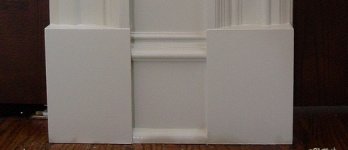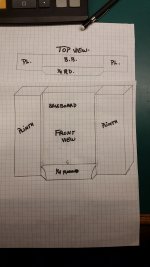You are using an out of date browser. It may not display this or other websites correctly.
You should upgrade or use an alternative browser.
You should upgrade or use an alternative browser.
does this look right
- Thread starter mike9
- Start date
nickao
Member
- Joined
- Feb 24, 2008
- Messages
- 4,617
A lot of times(and I prefer) the plinth blocks on the bottom to be thicker than the base trim so the base shoe fits between the plinth blocks like this:
[attachimg=1]
Is it possible at this point? To me this looks a whole lot better. If you are stuck there are loads of trim guys here that will toss out ideas. honeydokreg does a lot of this stuff.
[attachimg=1]
Is it possible at this point? To me this looks a whole lot better. If you are stuck there are loads of trim guys here that will toss out ideas. honeydokreg does a lot of this stuff.
Attachments
nickao
Member
- Joined
- Feb 24, 2008
- Messages
- 4,617
That shoe covers the gap between the flooring and wall if the base trim doesn't cover it. Sometimes the flooring dips and rises as well. Shoe covers this up. It is lot simpler to use shoe than to scribe the base trim to the floor if the floor is bad. And if the base trim is not high enough and the floor bad enough scribing looks awful. Shoe is also a design option, some people simply like and want it. Many trim designs look bad without it. To my eye the OP's trim scheme seems simple enough to look good without it.
The shoe should be attached to the wall not floor to let the floor move(most guys still toe into the floor).
If the floor is clean again the base trim eliminating the shoe it is an option.
The shoe should be attached to the wall not floor to let the floor move(most guys still toe into the floor).
If the floor is clean again the base trim eliminating the shoe it is an option.
PA floor guy
Member
- Joined
- Nov 25, 2012
- Messages
- 290
I normally install about 10k linear foot of shoe a year, sometimes twice that. Anyway, it depends on Whether it's natural wood or paint. Normally, when that happens, I notch it about an inch in, and then Bologna cut it. That is my favorite look. But for best results, I always look in other rooms and see what was done there and match it.
galwaydude18@gmail.com
Member
- Joined
- Mar 13, 2012
- Messages
- 842
The whole things looks way out of proportion and not nice. That's my opinion
nickao
Member
- Joined
- Feb 24, 2008
- Messages
- 4,617
Glue on another 1/4" to 3/8" to the back of the plinths, then put a detail on the top of the base trim and you will be golden.
At the same time you can run the base through a planer and take an 1/8 to 3/16" off if it isn't all up.
Your base trim seems really bulky, partly becasue of the square top. I think that may be the preceding posters issue. Other than that is sure looks like the traditional type trim we see around here, just a little less refined.
At the same time you can run the base through a planer and take an 1/8 to 3/16" off if it isn't all up.
Your base trim seems really bulky, partly becasue of the square top. I think that may be the preceding posters issue. Other than that is sure looks like the traditional type trim we see around here, just a little less refined.
Sparktrician
Member
- Joined
- Dec 4, 2009
- Messages
- 4,607
- Joined
- Jun 24, 2007
- Messages
- 10,357
Several good alternatives have already been suggested. Just for the sake of another opinion .......... it's a nice idea but I have to say that I don't like the way it looks. You said the plinth blocks are that tall in the rest of the house, what is the 1/4 round like in the rest of the house.
Seth
Seth
tiralie
Member
- Joined
- Jan 26, 2010
- Messages
- 3,617
mike9 said:The reason I went with that size plinth block is because the original moulding in the house had the same height plinth block.
It's easy to repeat errors of others in the name of efficiency and expediency, we have all done it.
I agree with others, that there are a lot of things just plain wrong with your initial solution.
Since you asked, here are my comments. These are straight from Get Your House Right. Get the book. It really helps with stuff like this.
1) the plinth block is too high and should at least terminate at the top of the base board.
2) If the rest of the house has a Georgian or Colonial style base and casing either stick with it or introduce a complimentary style. Your first example is neither modern nor (neo) classical. Pick a style and make your room work with in that convention. (This is also a mistake I have made)
2) the base board may be too high based on your ceilings. For an 8' ceiling a good height for the base board is +/- 5 1/2"
3) Use a shoe mold instead of a quarter round. I really detest the look of 1/4 round but it is appropriate in some instances.
4) Use a shoe mold that projects into the room less than the height.
Tim
Grasshopper
Member
- Joined
- Oct 6, 2014
- Messages
- 595
Tim,
Great link for the get your house right book. I just ordered from Amazon!
Great link for the get your house right book. I just ordered from Amazon!
Tim Raleigh said:mike9 said:The reason I went with that size plinth block is because the original moulding in the house had the same height plinth block.
It's easy to repeat errors of others in the name of efficiency and expediency, we have all done it.
I agree with others, that there are a lot of things just plain wrong with your initial solution.
Since you asked, here are my comments. These are straight from Get Your Youse Right. Get the book. It really helps with stuff like this.
1) the plinth block is too high and should at least terminate at the top of the base board.
2) If the rest of the house has a Georgian or Colonial style base and casing either stick with it or introduce a complimentary style. Your first example is neither modern nor (neo) classical. Pick a style and make your room work with in that convention. (This is also a mistake I have made)
2) the base board may be too high based on your ceilings. For an 8' ceiling a good height for the base board is +/- 5 1/2"
3) Use a shoe mold instead of a quarter round. I really detest the look of 1/4 round but it is appropriate in some instances.
4) Use a shoe mold that projects into the room less than the height.
Tim
Tim Raleigh said:Since you asked, here are my comments. These are straight from Get Your House Right. Get the book. It really helps with stuff like this.
I bought the book several months ago and finally hit the top of my reading list this week. This book is amazing. I think anyone who does any design or construction work should probably own it. The illustrations are really great. It reminds me of another invaluable reference, "Form, Space, and Order" by Francis D.K. Ching.
Similar threads
- Replies
- 35
- Views
- 5K
- Replies
- 17
- Views
- 15K
- Replies
- 2
- Views
- 358
- Replies
- 10
- Views
- 307





